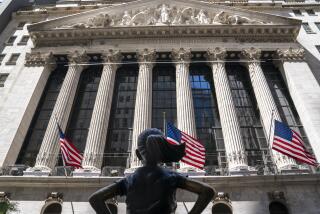Bull Market Keeps Setting Records; Dow Climbs 5.49
- Share via
NEW YORK — The stock market inched ahead today, extending the rise that has carried it to new record highs this week.
The Dow Jones average of 30 industrials gained 5.49 to 1,909.03.
Advancing issues outnumbered declines by about eight to seven on the New York Stock Exchange.
Big Board volume totaled about 150 million shares, against 147.67 million in the previous session.
The NYSE’s composite index rose 0.47 to 145.15. At the American Stock Exchange, the market value index was up 0.12 at 284.79.
Analysts said the market’s rise past the 1,900 level in the Dow Jones industrial average, while certainly welcomed on Wall Street, did not create any new surge of buying interest.
Many market participants were awaiting the government’s report Thursday on the employment situation for June.
The figures on such things as unemployment and the average work week were expected to set the tone for interest rates and the possibility of a cut in the Federal Reserve’s discount rate. If the economy remains sluggish, many economists expect the Fed to take action fairly soon to relax its credit policy.
Activity in the stock market is expected to start slackening Thursday as traders turn their thoughts to the long July 4 holiday weekend.
Most bond prices hardly budged early today except long-term government issues, which fell slightly. Interest rates remained near recent levels.
Action in the credit markets continued slow. Attendance has been sparse this week due to the approaching holiday.
The bellwether 30-year Treasury bond lost 5/16 point, which bumped its yield up to 7.24% from 7.23% late Tuesday.
Analysts said bond dealers have wearied of talk of a possible cut in the discount rate, the interest that the Federal Reserve charges on loans to financial institutions.
Speculation that the central bank would trim the key rate to enliven the lethargic economy has contributed to the recent strength in the bond and stock markets.
Although the discount rate--currently 6.5%--is the only interest rate that the Fed directly controls, adjustments in it frequently influence other credit charges. Lower interest rates would be welcomed by bond dealers because bond values improve when yields decline.
A Commerce Deparment report that said orders to U.S. factories for manufactured goods declined 0.1% in May went largely ignored. The news merely provided added evidence to support a widely held belief that the economy performed poorly in the first half of the year, analysts said.
In the secondary market for Treasury bonds, prices of short-term governments were unchanged, and most intermediate maturities were also unchanged except 10-year notes, which dipped 1/32 point, according to the investment firm of Salomon Bros. The 20-year bond dropped 3/8 point.
Treasury Indexes Slip
The movement of a point is equivalent to a change of $10 in the price of a bond with a $1,000 face value.
At midday in New York, the Merrill Lynch daily Treasury index, which measures price movements on all outstanding Treasury issues with maturities of a year or longer, was off 0.20 from Tuesday’s close at 117.40. The Shearson Lehman daily Treasury bond index, which makes a similar measurement, fell 0.77 to 1,230.60.
In corporate trading, industrials and utilities were unchanged in quiet dealings. Among tax-exempt municipal bonds, dollar bonds were unchanged while general obligations gained point in light trading.
Yields on three-month Treasury bills held steady at 6%. Six-month bill and one-year bill yields both dropped 2 basis points, to 5.95% and 6.01%, respectively. Each basis point equals one-hundredth of a percentage point.
The federal funds rate, the interest on overnight loans between banks, traded at 7%, up from 6.75% late Tuesday.
More to Read
Inside the business of entertainment
The Wide Shot brings you news, analysis and insights on everything from streaming wars to production — and what it all means for the future.
You may occasionally receive promotional content from the Los Angeles Times.










